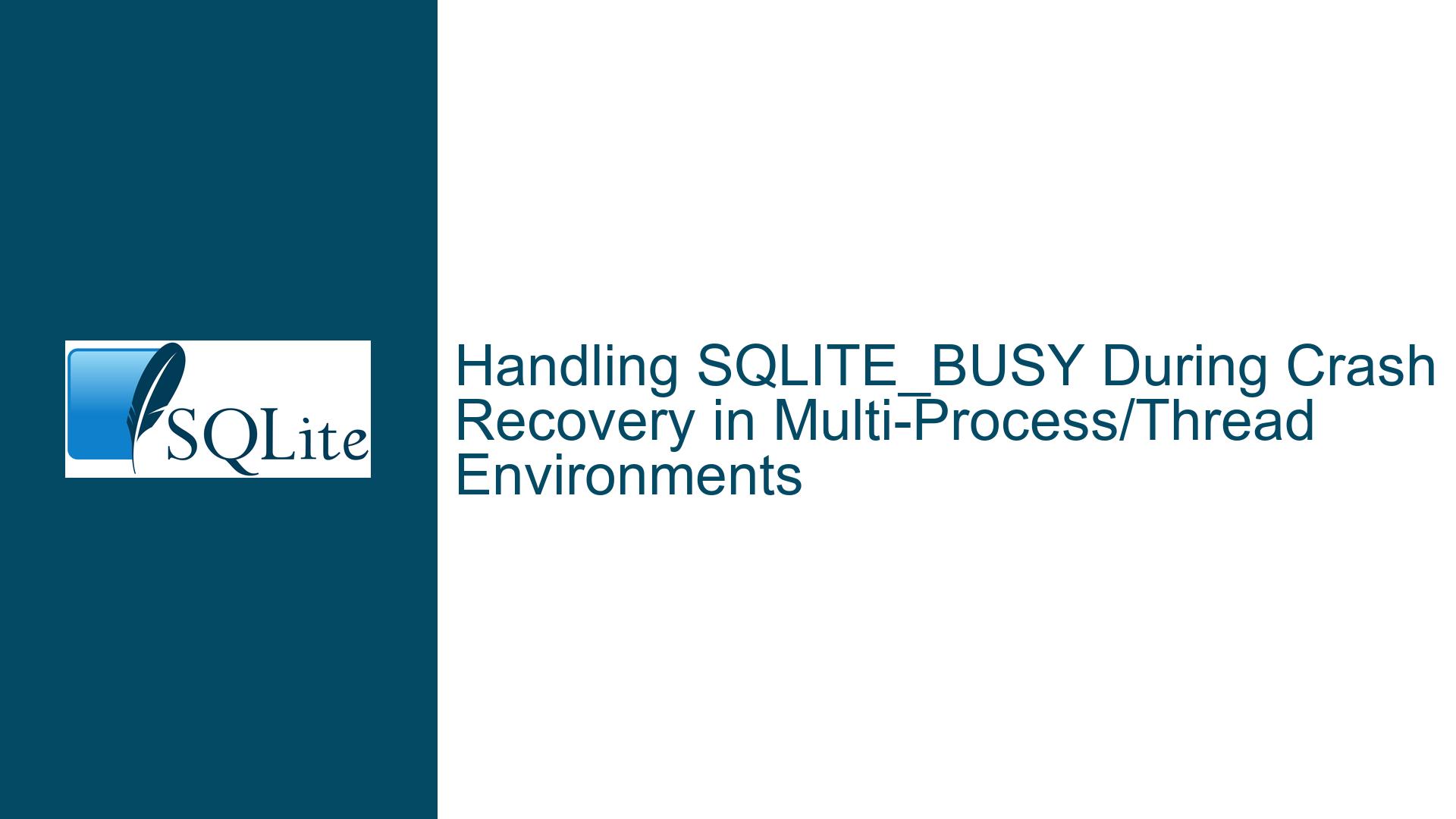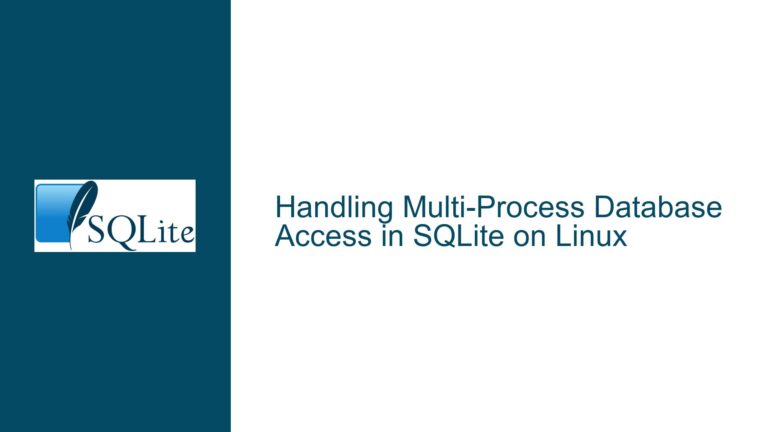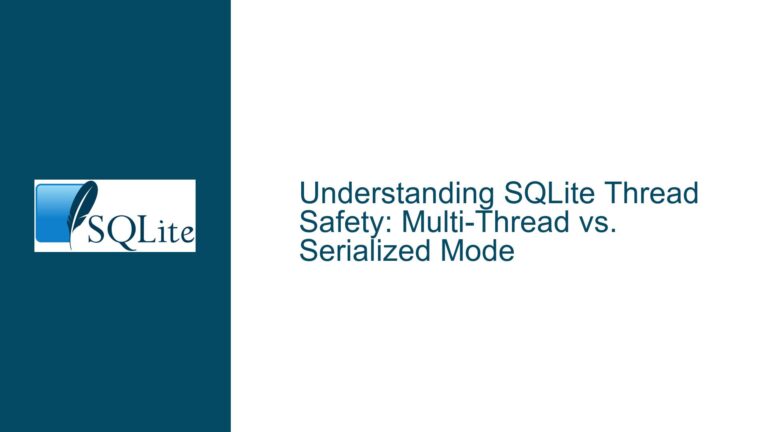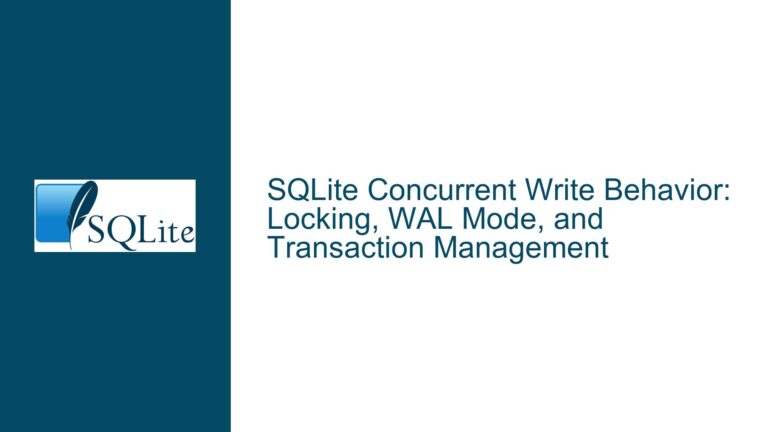Handling SQLITE_BUSY During Crash Recovery in Multi-Process/Thread Environments
Database Lock Contention During Crash Recovery: Mechanisms & Mitigations
Understanding SQLITE_BUSY During Rollback & WAL Recovery
SQLITE_BUSY errors arise when concurrent processes or threads attempt conflicting operations on a database. This becomes particularly problematic during crash recovery, where SQLite enforces exclusive locks to ensure data integrity. The core challenge lies in managing access to the database during recovery phases while avoiding polling-based solutions.
In rollback journal mode, recovery is triggered by the first transaction (read or write) after opening the database. A hot journal (indicating an incomplete prior transaction) forces SQLite to acquire an exclusive lock during recovery, which may block subsequent operations. In WAL mode, recovery occurs when the first new connection opens the database after a crash, holding an exclusive lock until recovery completes. Both scenarios create transient states where concurrent access attempts fail with SQLITE_BUSY.
The root issue is the lack of explicit control over when recovery occurs. Opening a database connection does not immediately trigger recovery; instead, recovery is deferred until the first operation that interacts with the database file. This creates a race condition: a process opening a connection might assume the database is ready for queries, only to encounter SQLITE_BUSY when recovery is triggered by another process’s operation.
Critical Factors Leading to Lock Contention During Recovery
1. Deferred Hot Journal Detection in Rollback Mode
SQLite defers hot journal detection until the first transaction begins. A read-only transaction that triggers recovery will escalate to an exclusive lock, blocking other connections. This behavior is counterintuitive, as users expect read operations to avoid write locks. The presence of a hot journal transforms a seemingly read-only operation into a write operation due to recovery requirements.
2. WAL Recovery Locking Semantics
In WAL mode, recovery is initiated by the first connection after a crash. This connection acquires an exclusive lock for the duration of recovery. Subsequent connections attempting operations during this window receive SQLITE_BUSY. Unlike rollback mode, WAL recovery is connection-triggered, not transaction-triggered, but the timing of connection establishment across processes remains unpredictable.
3. Absence of Preemptive Recovery Initialization
SQLite does not provide an API to explicitly trigger recovery during connection initialization. Developers must infer recovery readiness through indirect methods, such as executing no-op queries or monitoring file locks. This lack of deterministic control forces applications to handle SQLITE_BUSY as a transient error rather than a preventable condition.
4. Misconfigured Busy Handlers & Timeouts
While SQLite offers sqlite3_busy_timeout() and PRAGMA busy_timeout, these mechanisms rely on retries with increasing delays (up to 100ms). They do not guarantee avoidance of SQLITE_BUSY, especially during recovery, where lock durations may exceed timeout thresholds. Applications requiring prompt query execution or fairness in lock acquisition find these solutions inadequate.
5. Cross-Process Coordination Gaps
Applications lacking a centralized lock manager for database access cannot coordinate recovery phases across processes. Without a protocol to serialize recovery initialization, concurrent processes may repeatedly trigger recovery attempts, exacerbating lock contention.
Resolving Lock Contention via Recovery Orchestration
Forcing Early Recovery in Rollback Journal Mode
Step 1: Trigger Recovery During Connection Initialization
Execute a trivial read operation immediately after opening the database to force hot journal detection. Use a no-op query that requires a table read, such as SELECT COUNT(*) FROM sqlite_master;. This forces SQLite to check for a hot journal and perform recovery before the first "real" transaction.
Implementation Example (C API):
sqlite3 *db;
sqlite3_open("database.db", &db);
sqlite3_exec(db, "SELECT COUNT(*) FROM sqlite_master;", NULL, NULL, NULL);
Wrap this initialization step in an exclusive lock (e.g., using file locks or mutexes) to prevent concurrent processes from triggering recovery simultaneously.
Step 2: Centralized Lock Management
Use an external lock (e.g., flock() on Unix or LockFileEx() on Windows) to serialize database initialization. Only the process holding the lock may open the database and execute the no-op query. Once recovery completes, release the lock, allowing other processes to proceed.
Lock Pseudocode:
int fd = open("database.db", O_RDWR);
flock(fd, LOCK_EX); // Block until exclusive lock acquired
sqlite3_open("database.db", &db);
sqlite3_exec(db, "SELECT 1;", NULL, NULL, NULL);
flock(fd, LOCK_UN);
close(fd);
Step 3: Transition to Shared Locks Post-Recovery
After recovery, downgrade the lock to shared mode for read-only connections. Use SQLite’s SQLITE_OPEN_READONLY flag for connections that do not require write access, reducing contention.
Handling WAL Mode Recovery Contention
Step 1: Checkpointing Before Connection Pooling
Force a checkpoint during application startup to finalize any incomplete WAL transactions:
sqlite3_open_v2("database.db", &db, SQLITE_OPEN_READWRITE, NULL);
sqlite3_wal_checkpoint_v2(db, NULL, SQLITE_CHECKPOINT_FULL, NULL, NULL);
This ensures that the WAL file is empty before allowing general database access.
Step 2: Serializing Initial Connections
Use a dedicated "recovery coordinator" process/thread that opens the database first after a crash. This coordinator performs recovery and signals other processes (via IPC mechanisms like semaphores or named pipes) that the database is ready.
Example Architecture:
- Process A crashes, leaving a WAL file.
- Process B starts, acquires an exclusive lock, opens the database, and triggers recovery.
- Process B writes a "ready" flag to a control file or sends a broadcast message.
- Other processes wait for the "ready" signal before connecting.
Step 3: Monitoring sqlite3_wal_checkpoint_v2 Results
Loop checkpoint attempts until SQLITE_OK is returned, indicating no active WAL transactions:
int rc;
do {
rc = sqlite3_wal_checkpoint_v2(db, NULL, SQLITE_CHECKPOINT_FULL, NULL, NULL);
} while (rc == SQLITE_BUSY);
This is effective in scenarios where the WAL file is small and checkpointing is quick.
Cross-Mode Best Practices
1. Connection Pool Warm-Up
Pre-open a fixed number of connections during application initialization, forcing recovery to occur once. Subsequent connections reuse the already-recovered database state.
2. Leveraging SQLITE_OPEN_EXCLUSIVE Flag
Open the database with SQLITE_OPEN_EXCLUSIVE for the first connection to guarantee sole access during recovery:
sqlite3_open_v2("database.db", &db, SQLITE_OPEN_READWRITE | SQLITE_OPEN_EXCLUSIVE, NULL);
This fails if another process has the database open, ensuring only one recovery operation proceeds.
3. Event-Driven Notification Systems
Replace polling with OS-level notification primitives:
- Windows: Use
WaitForSingleObjecton a named event. - Unix: Use
inotifyto monitor database file changes.
When recovery completes, the recovering process signals the event, notifying waiters.
4. Custom Busy Handlers with Backoff
Implement a busy handler that sleeps until a lock is released, using exponential backoff:
int busy_handler(void *data, int attempts) {
if (attempts >= 5) return 0; // Abort after 5 attempts
usleep(100000 * (1 << attempts)); // 100ms, 200ms, 400ms, etc.
return 1;
}
sqlite3_busy_handler(db, busy_handler, NULL);
This minimizes polling overhead while allowing transient lock contention to resolve.
5. File Lock Escalation Monitoring
Use low-level file locking APIs to detect when the database transitions from exclusive to shared locks. For example, on Linux:
struct flock lock = {
.l_type = F_WRLCK,
.l_whence = SEEK_SET,
.l_start = 0,
.l_len = 0
};
fcntl(fd, F_GETLK, &lock);
if (lock.l_type == F_UNLCK) {
// Exclusive lock released; safe to proceed
}
Debugging Persistent SQLITE_BUSY_RECOVERY Errors
1. Identify Recovery Triggers
Log all database connections and transactions to pinpoint which operation triggers recovery. Enable SQLite’s logging with:
sqlite3_config(SQLITE_CONFIG_LOG, log_callback, NULL);
Review logs for "cannot start transaction within transaction" or "database is locked" messages.
2. Analyze WAL File State
Inspect the WAL file size and checkpoint status:
PRAGMA wal_checkpoint(TRUNCATE);
SELECT * FROM pragma_wal_checkpoint;
A large WAL file indicates checkpoint starvation; mitigate by reducing wal_autocheckpoint intervals.
3. Validate External Locking Protocols
Ensure file locks are correctly acquired and released using lsof (Unix) or HandleEx (Windows) to identify leaked locks.
4. Test Crash Scenarios
Simulate application crashes (e.g., kill -9) to verify recovery robustness. Monitor whether post-crash recovery reliably transitions the database to a usable state.
By systematically addressing recovery timing, lock coordination, and concurrency protocols, developers can eliminate SQLITE_BUSY errors during crash recovery while maintaining high availability in multi-process/thread environments.






